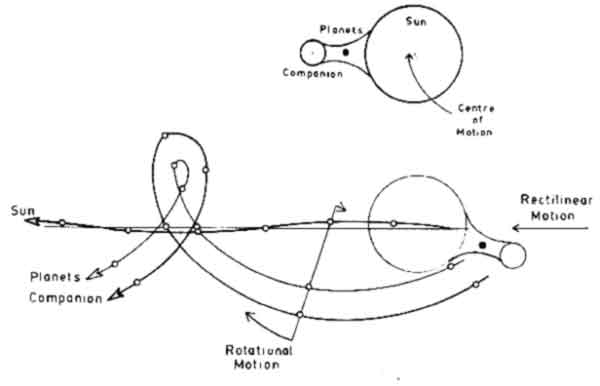CHAPTER ONE
Contrary to the hypothesis that the Solar System was born as and has evolved as a single star system, it is here claimed that the Solar System was and is a binary system. The binary system was formed when the primitive Sun fissioned. Several planets were generated in the neck of the fissioning pair and co-revolved about the Sun synchronously with the companion (see Figure 1).
The remaining planets were generated, one or more at a time, in several episodes, as the companion became unstable because of a changing galactic environment which we will discuss in Chapter Three.
Figure 1. Dumb-bell Motion of Solaria Binaria

The binary system rotates like a lopsided dumb-bell as it moves through galactic space. The Sun orbits about the planets and the companion as they also orbit about the Sun. To be precise, all bodies in the system orbit about its center of motion with the same period.
Jupiter can be taken to be the remnant binary partner [1] . This => quantavolutionary [2] conception of a rapidly developed solar binary system is consonant with observations of nearby star systems. To seventeen light-years, or about one hundred million times the Earth-Sun distance of 150 => gigameters, there are forty-five star systems consisting of sixty stars and seven dark => unseen bodies. Among these are many => physical binary systems.
Sixty-one percent of the sixty nearest stars are components of a double or triple star system. Inasmuch as we cannot judge the organization of distant star systems, this statistic may or may not characterize the starry Universe. Even within our sample of sixty nearby stars, the star density and the binary frequency drop with increasing distance (van de Kamp 1971, p109), a suspicious fact.
Nothing that we know of the Sun is exclusively a property of a single star system or would be surprising if found in a => double star system.
On the average the => principals in a physical binary system are separated by approximately 18 => astronomical units. At one extreme, separations of up to twelve thousand astronomical units are deduced; at the other, the stars orbit one another with their surfaces in contact (see Technical note D).
We see Solaria Binaria as a double star system evolving from the close extreme to a system showing increasing separation of the principals with time.
The typical => visual binary system that has been analyzed contains principals whose separations, periods, total masses, and orbital shapes are not markedly different form the Sun coupled with any one of the major planets of the present Solar system (Note D). The present Solar System differs from other visual binaries only when the => luminosity and mass rations of the principals are considered. The observed features of visual binary systems are not an inconsistent final state for a physical binary system evolving in the manner that will be proposed here for Solaria Binaria.
The present mass ratio between the Sun and its planets would seem inconsistent with observed binary systems were it not for the fact that these latter are all visually observed and do not exclude the potential presence of binaries where the minor principal is undetectable presently by any observation. Further, as we shall show in Chapter Four the brightness of the Sun and its companion( s) was markedly different in the binary phase than in the present system.
The currently accepted cosmogony of the Sun and the planets is dominated by concepts of gravitation, great stretches of time, and the stability of stellar and Solar System motions. In this cosmogony one looks backward and forward in time, confident that the world has been and will be found in place under known conditions. One assumes the order of things in accord with a three-hundred-year-old theory backed up by centuries of systematic observations. Occasionally, but nowadays with increasing frequency, new scientific discoveries are "surprising" or anomalous, within the frame of the cosmogony. For instance, devastation has been wide-spread both on the Earth and on the other planets whose surface details are visible. Because theories had not predicted such instability, these disruptive events are insistently termed episodic and localized, and relegated to remote times. As will be shown, the prevailing cosmogony of science cannot cope with increasing numbers of surprising and anomalous observations. Sooner or later an alternative cosmogonical theory is invited. The mutating evidence suggests that a cosmogony can be constructed which does not require a long time to evolve our habitable world, within which major readjustments of the planetary orbits and environments are possible, and which redefines the set of forces that bring about change (see Technical Note C)
We began with the theory that the Solar System originated as a binary star system and has evolved to the present as such. In the course of elaborating this theory, we shall have to develop and use new tools of analysis - a general concept of electricity (see Technical Note B); new ways of viewing the origins of the atmosphere, lithosphere, and biosphere; an unusual form of legendary and historical inquiry (see Technical Note A); and revised measures of time for the process.
Accepting the notion that the Solar System may be presently at the end of a long binary trail leads to a theory that the Sun is electrical. This fundamental idea is the topic of the next chapter.
Notes on Chapter 1